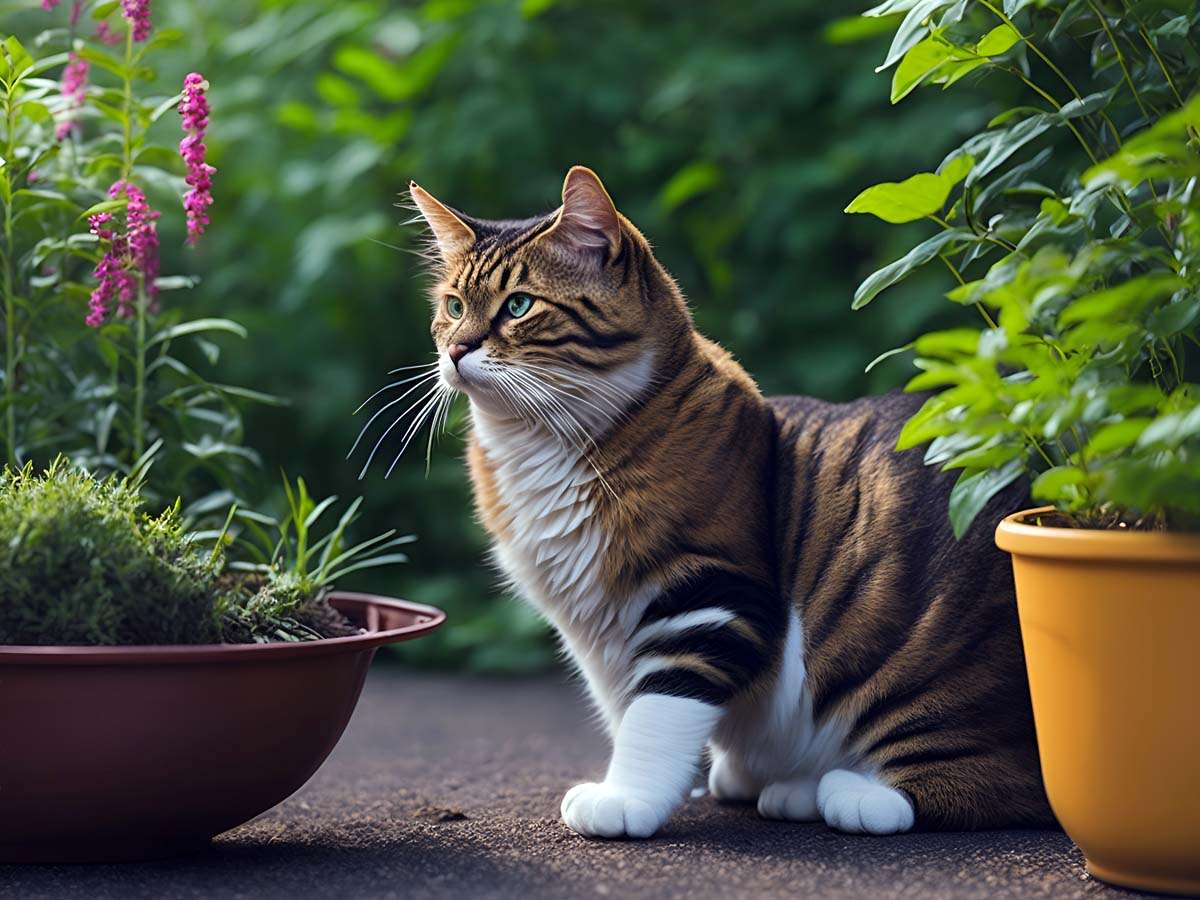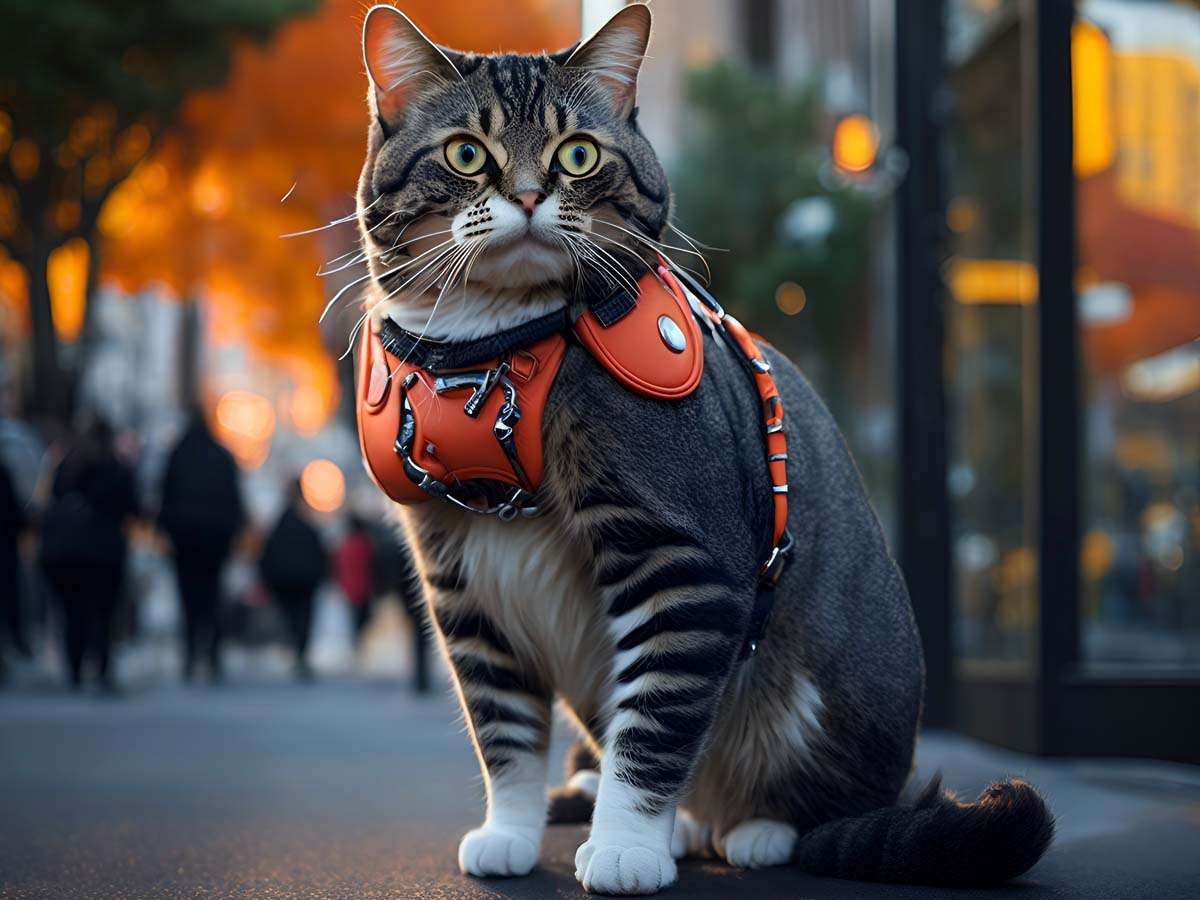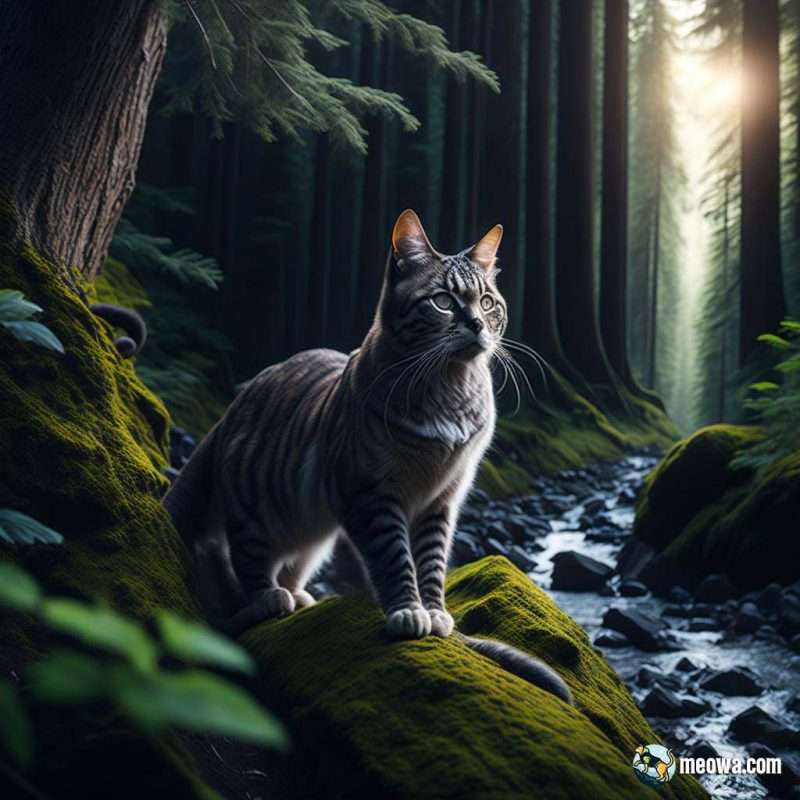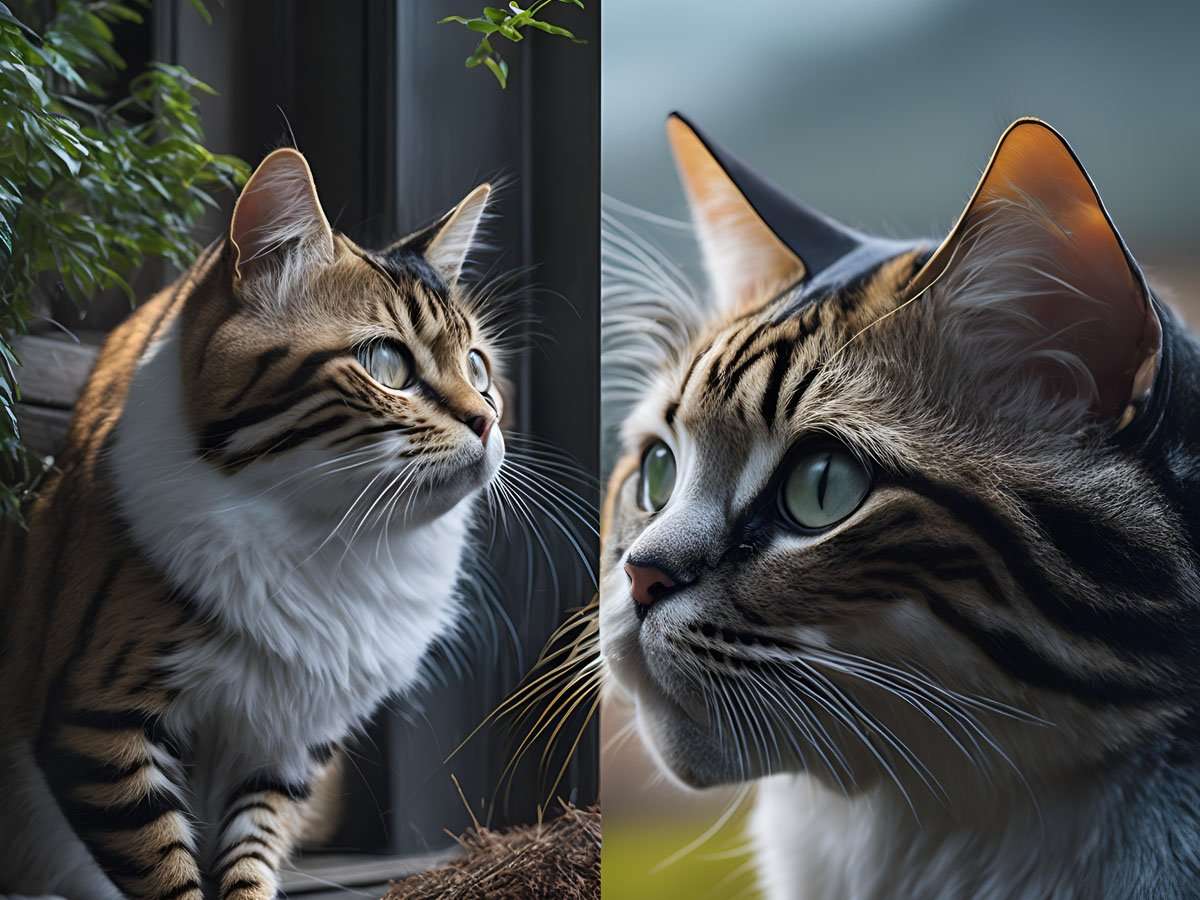Indoor vs Outdoor Cat: Choosing the Ideal Lifestyle for Your Kitty
As a cat owner, one of the most important decisions you’ll face is whether to keep your feline friend indoors or allow them to roam freely outside. The debate around indoor vs outdoor cats is one that has been ongoing for years, with passionate arguments on both sides. There are several factors that contribute to this decision, such as your cat’s personality, lifestyle, and environment.
It’s essential to consider your cat’s individual needs when making this choice, as every cat is unique. What might work for one feline might not be suitable for another. That’s why, in this comprehensive guide, we’ll delve into the benefits and drawbacks of both indoor and outdoor lifestyles for cats. We will also explore the factors you need to take into account when deciding what’s best for your beloved pet.
Our goal is to provide you with all the information you need to make an informed decision that will keep your cat happy, healthy, and safe. So, let’s jump right into the fascinating world of indoor vs outdoor cats!
Benefits of Indoor Cats

So you’ve decided to keep your cat indoors. Congratulations! You’ve just signed up for a lifetime of watching your cat perform acrobatics on your furniture, knocking things off shelves, and turning your home into their personal playground. But don’t worry, the benefits of indoor cats far outweigh the occasional knocked-over vase.
Safety
One of the most significant advantages of keeping your cat indoors is the increased safety it provides. Indoor cats are less exposed to various hazards such as traffic (those pesky cars seem to have a personal vendetta against cats), predators (like coyotes and large birds of prey that think your cat is an all-you-can-eat buffet), and fights with other animals that could result in injury or even death. Moreover, indoor cats have a lower risk of contracting illnesses and parasites, such as fleas, ticks, and worms, since they are not exposed to other animals and the great outdoors. Your indoor cat might miss out on some adventures, but at least they won’t be starring in their own real-life version of “The Hunger Games.”
Longer Lifespan
Did you know that indoor cats tend to live longer than their outdoor counterparts? Statistics show that indoor cats can have a life expectancy of up to 15 years, while outdoor cats may only live for around 5 years on average. That’s a lot of extra time for your cat to perfect its art of lounging on your favorite chair! This is mainly because indoor cats face fewer threats from outdoor dangers, such as accidents or encounters with predators. By keeping your cat indoors, you’re providing them with a safer environment and a greater chance of living a long, healthy life.
Better Monitoring of Health
When your cat lives indoors, it’s much easier to keep an eye on their eating habits, behavior, and overall health. You’ll quickly notice any changes in their routine, such as a loss of appetite or sudden lethargy, which could indicate a health issue that needs attention. With indoor cats, detecting health problems becomes more manageable, as you can address them promptly and ensure they receive timely veterinary care. After all, your indoor cat is like a furry roommate – you’ll know when they’re “feline” under the weather (pun intended).
Environmental Impact
Indoor cats have a significantly lower impact on the environment compared to their outdoor counterparts. Outdoor cats are known to prey on small mammals, birds, and reptiles, which can negatively affect local ecosystems and cause a decline in native wildlife populations. By keeping your cat indoors, you’re helping to protect vulnerable species and promote a healthier environment.
Outdoor Adventures for Indoor Cats
Who says indoor cats can’t enjoy a taste of the great outdoors? Supervised outdoor time on a leash or in a secure enclosure like a “catio” can offer your indoor cat the opportunity to experience fresh air, sunshine, and new sights, sounds, and smells. By providing controlled and safe outdoor access, you can give your cat the best of both worlds, keeping them healthy and entertained.
Drawbacks of Indoor Cats
While indoor cats enjoy numerous benefits, there are some potential downsides to this lifestyle. It’s crucial to be aware of these challenges and find ways to address them to ensure your indoor cat remains happy and healthy.
Physical and Mental Stimulation
One of the main challenges for indoor cats is providing adequate physical and mental stimulation. Outdoor cats have constant access to a changing environment that offers ample opportunities for exercise, exploration, and hunting. To keep your indoor cat engaged and active, you’ll need to invest time and resources in creating a stimulating environment. This can include puzzle toys, regular play sessions, and various forms of enrichment like scent and texture exploration.
Obesity and Health Issues
Indoor cats are more prone to obesity and related health issues due to their sedentary lifestyle. A lack of exercise combined with overfeeding can lead to weight gain, which can, in turn, increase the risk of developing diabetes, heart disease, and other health problems. To keep your indoor cat at a healthy weight, ensure they receive a balanced diet and plenty of exercise through interactive play toys.
Behavioral Issues
Boredom and lack of stimulation can lead to behavioral issues in indoor cats, such as inappropriate scratching, aggression, or excessive vocalization. Addressing these issues requires identifying the underlying cause and finding ways to mitigate it, such as offering more playtime, introducing new toys, or creating a more engaging environment.
The Cost of Cat-Proofing Your Home
Keeping your cat indoors means cat-proofing your home to prevent accidents and protect your belongings. This can involve investing in sturdy scratching posts, heavy-duty furniture covers, and cat trees to prevent your cat from damaging your furniture and other possessions. While these costs can add up, they are a necessary investment to ensure your cat’s safety and happiness indoors.
Benefits of Outdoor Cats

Maybe you’re considering the outdoor life for your feline friend. While this lifestyle has its risks, it also offers some unique benefits that indoor cats miss out on. So let’s explore what your cat can gain from embracing its wild side.
Natural Instincts and Exploration
Outdoor cats have the opportunity to unleash their inner tiger by hunting and exploring their surroundings. They can stalk birds, chase butterflies, and engage in the age-old game of “cat vs. squirrel.” With exposure to various scents, sights, and sounds, they can maintain a connection with their wild instincts. So, while your outdoor cat might bring you the occasional “gift” (like that half-eaten mouse on your doorstep), at least they’re in touch with their primal side.
Physical Exercise and Fitness
Outdoor cats have a built-in gym membership, complete with a never-ending obstacle course. They enjoy increased physical activity, climbing trees, and playing with other feline friends. This active lifestyle helps keep them in shape and less prone to obesity and related health issues. So, while your indoor cat might be working on its “dad bod,” your outdoor cat is training for the feline Olympics.
Reduced Boredom and Stress
Variety is the spice of life, and outdoor cats get their daily dose of excitement by exploring the great outdoors. This dynamic environment helps reduce boredom and stress, making them less likely to develop behavioral problems like scratching furniture or marking territory indoors. An outdoor cat’s mental stimulation and enrichment come from the ever-changing world around them, so don’t be surprised if they return home with stories of their grand adventures (if only they could talk!).
Social Interaction with Other Cats
For some cats, social interaction with other felines is an essential part of their well-being. Outdoor cats have more opportunities to interact with other cats in their neighborhood, which can help satisfy their social needs. However, it’s essential to monitor these interactions, as fights and territorial disputes can occur, potentially leading to injury or illness.
Lower Risk of Obesity and Associated Health Problems
Outdoor cats generally have more opportunities for exercise and physical activity, reducing their risk of obesity and associated health problems. An active lifestyle helps maintain muscle tone, joint health, and overall fitness, contributing to better long-term health.
Drawbacks of Outdoor Cats
Before you decide to set your furry friend free in the great outdoors, it’s essential to consider the potential drawbacks. While the outdoor life may seem like a feline fantasy, it comes with its own set of challenges and risks.
Shorter Lifespan
As mentioned earlier, outdoor cats tend to have shorter lifespans compared to their indoor counterparts. While they may enjoy a life of chasing squirrels, scaling fences, and practicing their stealth skills on unsuspecting birds, these adventures come at a cost. Outdoor cats face numerous dangers, from traffic accidents to predators, that can drastically reduce their life expectancy. So, if you want your cat to stick around for many years to come, it might be best to keep them inside where it’s safe and cozy.
Exposure to Parasites and Diseases
When your cat ventures outdoors, they don’t just pick up leaves and dirt on their fur – they also become exposed to a variety of parasites and diseases. Outdoor cats are more likely to contract fleas, ticks, and worms, which can affect their health and even be transmitted to other animals or humans. In addition to pesky parasites, outdoor cats face a higher risk of contracting diseases such as feline leukemia, feline immunodeficiency virus (FIV), and feline infectious peritonitis (FIP). These illnesses can be life-threatening and require ongoing veterinary care. So, while your outdoor cat may enjoy the thrill of exploring the neighborhood, they may also bring home some unwanted hitchhikers.
Dangers from Traffic, Predators, and Other Hazards
The great outdoors is filled with potential hazards that can spell disaster for your adventurous feline. Cars may not have it in for cats, but they certainly don’t go out of their way to avoid them either. Busy roads can be incredibly dangerous, leading to accidents and injuries. Outdoor cats may also come face-to-face with predators, like coyotes or large birds of prey, which can lead to a not-so-happy ending for your furry friend. And let’s not forget about other hazards, such as ingesting poisonous plants, exposure to chemicals, or getting trapped in a neighbor’s garage. The outdoor life may seem like a thrilling adventure, but it can be a perilous one too.
Environmental Impact and Wildlife Conservation
We all know that cats are expert hunters, and while this skill may be impressive, it can also have severe consequences for local wildlife. Outdoor cats are responsible for the deaths of billions of birds and small mammals each year, contributing to the decline of native species and disrupting ecosystems. As much as you might appreciate your cat’s hunting prowess, the environment and wildlife populations don’t feel the same way. By keeping your cat indoors, you’re not only protecting them but also helping to conserve local wildlife and maintain a balanced ecosystem.
So, before you throw open the door and send your cat on a grand outdoor adventure, weigh the pros and cons carefully. While there are some undeniable benefits to outdoor living, the risks and drawbacks are significant. Ultimately, the decision comes down to what is best for your cat and your individual situation. Just remember that, with a little effort, you can create a safe, engaging, and fulfilling indoor environment that provides your cat with the best of both worlds.
Factors to Consider When Choosing Indoor vs Outdoor

So, you’ve weighed the pros and cons of indoor vs outdoor cat lifestyles, but you’re still on the fence. Choosing between indoor and outdoor living for your feline companion isn’t always a straightforward decision. To make the best choice, you should consider various factors to ensure that both you and your cat are happy and comfortable. Here’s a list of essential factors to keep in mind when deciding between indoor and outdoor living:
Cat’s Personality and Breed
Not all cats are created equal, and their personalities can play a significant role in determining the best living situation for them. Some cats are natural-born explorers, channeling their inner Indiana Jones, while others are more like Garfield, preferring the security and warmth of home.
Take the time to observe your cat’s behavior and preferences. Do they constantly try to escape outside like a feline Houdini, or are they more interested in snuggling up on the couch and binge-watching Netflix with you? Renowned cat behaviorist, Jackson Galaxy, advises that understanding your cat’s inherent nature is crucial for finding a living situation that aligns with their personality. You can watch his entertaining video on cat personalities here. Remember, your cat is unique – just like a snowflake, but with fur and an attitude.
Best Outdoor Cat Breeds
If your heart is set on an outdoor cat, some breeds are better suited for the adventurous life than others. These intrepid felines thrive in the great outdoors, reveling in their natural surroundings and engaging in a wild game of “Survivor: Feline Edition.” Here are some of the best outdoor cat breeds:
- Bengal: As you mentioned, the athletic and energetic Bengal is a natural-born explorer. With their wild ancestry, these cats have a strong hunting instinct and love to climb, run, and pounce. They’re like the feline version of Indiana Jones – always on the hunt for adventure.
- Savannah: Another breed with wild roots, the Savannah cat is a confident and curious creature. Their impressive jumping ability and endless energy make them perfect candidates for outdoor escapades. Just remember, they might bring home some unexpected “treasures” from their adventures.
- Maine Coon: These gentle giants are known for their intelligence and adaptability. They’re skilled hunters and can withstand harsh weather conditions, making them ideal outdoor companions. Plus, their luxurious fur will keep them warm during those cold winter nights.
- Norwegian Forest Cat: Hailing from the snowy lands of Norway, these fluffy felines are built for outdoor life. They’re equipped with a waterproof coat, strong climbing skills, and a love for exploration. They’ll be more than happy to “Viking” their way through the great outdoors.
- Abyssinian: If you’re looking for a cat with the energy of a hyperactive toddler, look no further than the Abyssinian. These playful and agile cats are always on the move, making them well-suited for outdoor adventures. Be prepared for endless games of chase and an inexhaustible curiosity.
If you’re interested in finding the best outdoor cat breeds for your adventurous lifestyle, Meowa has compiled a list of some of the top contenders. From the athletic and energetic Bengal to the playful and agile Abyssinian, these cats are natural-born explorers who will thrive in the great outdoors. Check out Meowa’s list of the best outdoor cat breeds for more information and helpful tips.
Breeds That Are More Indoor
On the other hand, some cats prefer the simple life – lounging on a cozy couch, napping in a sunbeam, and binge-watching their favorite bird-watching show (aka the view out the window). Here are some breeds that are content with indoor living:
- Persian: The quintessential lap cat, Persians are known for their laid-back and loving nature. They’re more than happy to live a life of leisure indoors, surrounded by comfy pillows and doting humans. They’re like the feline embodiment of a pampered aristocrat.
- Ragdoll: Aptly named, Ragdolls have a penchant for going limp when picked up, and they love to be carried around like a baby. These affectionate cats are more than happy to stay indoors, snuggling with their favorite human and practicing their “purr therapy” skills.
- Scottish Fold: These adorable cats, with their folded ears and big eyes, are known for their calm and gentle nature. They prefer the comforts of home and are content to watch the world go by from a safe and cozy vantage point. Think of them as the feline equivalent of a homebody.
- Siamese: While Siamese cats are known for their intelligence and athleticism, they’re also incredibly social and form strong bonds with their humans. They’re content to stay indoors and engage in playtime with their favorite person, acting as your very own feline shadow.
- Sphynx: With their hairless bodies, Sphynx cats are more susceptible to temperature fluctuations and sunburns. This makes them better suited for indoor living, where they can stay warm and safe from the elements. Plus, they’ll be right there to provide you with a unique, hairless cuddle buddy.
Remember, these are generalizations, and each cat is unique. Just like people
Location and Environment
Before you release your cat into the wild (aka your backyard), assess the safety of the surrounding area. Is your home near a busy street or in an area with predators like coyotes? If so, an indoor lifestyle might be a better fit. Consider local climate and weather conditions – harsh winters or scorching summers might make outdoor living difficult. And don’t forget to check local laws and regulations – some communities have restrictions on outdoor cats to protect local wildlife.
The area surrounding your home and the space available indoors can significantly impact your cat’s quality of life. You wouldn’t want to throw a lavish party in a cramped studio apartment, so why force your cat into a living situation that doesn’t suit them?
Assess the safety of your neighborhood like Sherlock Holmes: is it near busy roads where cars zoom by like they’re in a Fast and Furious movie, or are there known predators like coyotes that might have your cat on their dinner menu? Consider the local climate and weather conditions as well – harsh winters or sweltering summers could make outdoor living difficult or even dangerous for your cat.
Owner’s Lifestyle and Commitment
Finally, take a good look in the mirror and consider your own lifestyle and commitment. Are you able to provide a stimulating indoor environment filled with toys, scratching posts, and perches? Do you have the time and patience to supervise outdoor activity or commit to leash training? Balancing your preferences with your cat’s needs is crucial when deciding between an indoor and outdoor lifestyle.
Evaluate the space you have available indoors to create a stimulating and engaging environment for your cat. Vertical space is especially important for indoor cats, so consider adding shelves and cat trees to keep them entertained. Remember, your cat’s indoor kingdom should resemble Disneyland, not Alcatraz.
Veterinary and Care Costs
Finally, take into account the potential veterinary and care costs associated with your cat’s living situation. Outdoor cats might be more prone to injuries, parasites, and diseases, leading to more frequent (and expensive) vet visits. According to the Humane Society, the total annual costs for an indoor cat range from $340 to $900, while the total annual costs for an outdoor cat range from $475 to $1,250. Additionally, the American Veterinary Medical Association (AVMA) suggests that indoor cats tend to have lower veterinary costs compared to their outdoor counterparts.
On the other hand, indoor cats might require more toys, scratching posts, and other accessories to keep them entertained and mentally stimulated, which can also add up over time. Think of these expenses as an investment in your cat’s happiness and well-being – just like you’d invest in a gym membership or a night out with friends.
By considering all these factors, you can make an informed decision that best suits your cat’s personality, lifestyle, and environment. Remember, a happy cat means a happy owner, and finding the right balance between safety and adventure will make both of your lives more enjoyable.
Local Laws and Regulations
Before you let your cat roam the great outdoors, you should familiarize yourself with local laws and regulations regarding outdoor cats. Just like there are rules for humans, some communities have restrictions in place to protect local wildlife from our feline friends.
Check if your neighborhood or apartment complex has rules or guidelines about outdoor cats. Some areas might require cats to be leashed or confined to a designated area. You don’t want your cat to be a wanted criminal in your community, so always follow the law and be a responsible cat owner.
Ultimately, it’s important to remember that every cat is unique, and what works for one feline friend may not work for another. By taking the time to understand your cat’s needs and preferences, you can create a living situation that keeps them healthy, happy, and content – whether that’s ruling the great indoors or conquering the wild outdoors. With patience, love, and understanding, you and your cat can navigate the world together, forming a bond that lasts a lifetime.
Compromise: Supervised or Controlled Outdoor Access for Indoor Cats
Can’t decide between indoor and outdoor life for your cat? Why not mix it up like a crazy cat person cocktail? By providing supervised or controlled outdoor access, you can give your cat the chance to explore the great outdoors while ensuring their safety (and your sanity). You might be wondering, “how to take your cat outside safely?” We’ve got you covered!
Cat Enclosures and Catio Extravaganza

A cat enclosure or “catio” provides your cat with a secure outdoor space where they can enjoy fresh air and sunshine without the risks associated with roaming free. Think of it as a kitty Club Med! If your cats want to go outside, catios are the perfect solution. Catios come in various shapes and sizes, from small window boxes to elaborate backyard structures that would make any feline feel like royalty. Some cat owners even transform their balconies or porches into cat-safe zones! When building or purchasing a catio, consider factors such as:
- Size: Give your cat enough room to move, stretch, and play.
- Location: Ensure access to sunlight and shade, plus some sweet bird-watching spots.
- Materials: Use sturdy, weather-resistant materials that can withstand your cat’s claws and curious antics.
Leash Training and Harness Walking: Feline Fitness Adventure

Who says only dogs can enjoy walks? If you’re wondering “how to make an indoor cat an outdoor cat”, leash training and harness walking are excellent ways to provide your cat with controlled outdoor access, and they’ll be the envy of every neighborhood canine. Benefits of leash training include:
- Increased bonding with your cat (because who doesn’t love a little extra quality time?)
- The opportunity to explore new environments together (think of the Instagram-worthy moments!)
- A chance for your cat to burn off some energy and stay fit
When letting house cats outside, leash training is a great option. To succeed in leash training, start slowly, use positive reinforcement (treats, please!), and invest in the right equipment, like an escape-proof cat harness. With patience and practice, you and your cat will be the talk of the neighborhood as you strut down the sidewalk together like a feline fashion show.
If you’re considering “how to make my indoor cat outdoor”, remember that it’s important to take it slow when letting an indoor cat outside for the first time. Begin with short, supervised outings and gradually increase the duration as your cat becomes more comfortable.
Go Wild: Camping, Hiking, and Traveling with Your Adventure Cat



For those who want to take their cat’s outdoor experiences to the next level, consider taking your kitty on camping trips, hiking adventures, or even just a casual city walk. You can even invest in a cat backpack or stroller to make traveling with your feline friend a breeze. Just remember:
- Always prioritize your cat’s safety and well-being
- Ensure they’re comfortable with their gear (harness, backpack, or stroller) before embarking on an adventure
- Keep an eye on your cat’s stress levels and be prepared to adjust your plans if necessary
By mixing up your cat’s indoor and outdoor experiences, you’ll create an enriching life for your furry friend while keeping them safe and happy. Now go on and unleash your inner cat whisperer!
The Great Feline Finale: A Purr-fect Conclusion
Well, folks, we’ve traversed the indoor vs outdoor cat debate like a cat scaling a towering cat tree, and it’s time to wrap up this fur-tastic journey. But before we end this feline escapade, let’s take a quick catnap (oops, we mean recap!) of the main points:
- Indoor cats enjoy increased safety, longer lifespans, and may have a lesser impact on the environment, while outdoor cats get to flex their natural instincts and engage in wild shenanigans.
- However, indoor cats may require extra stimulation to avoid boredom, and outdoor cats face the perils of the big, bad world out there (think predators, diseases, and pesky fleas).
Now, we know what you’re thinking: “Tell me, wise cat guru, what’s the best choice for my feline friend?” The answer, dear reader, lies in considering your cat’s needs, personality, and environment. Is your cat a fearless explorer, or more of a fluffy couch potato? Do you live in a bustling city or a quiet countryside? The secret sauce to making the purr-fect decision is understanding your cat’s unique quirks and your living situation.
As you ponder, don’t forget that turning your indoor cat into an adventure cat is a fantastic compromise that comes with its own set of benefits. With the right training and gear, you can give your kitty a taste of the great outdoors without compromising their safety.
When considering whether to keep your cat indoors or allow them outdoor access, it’s important to weigh the benefits and risks of each option. As noted in a 2017 report by Humane Canada, 56% of Canadian cat owners keep their cats indoors, while 16% provide controlled outdoor access through methods such as direct supervision, enclosures, or harness use. Another 28% allow their cats some level of uncontrolled outdoor access. This report provides insight into the prevalence of different living situations for cats in Canada and highlights the importance of making informed decisions about our pets’ welfare.
So, as you contemplate this great conundrum, remember that your cat’s happiness and well-being are the ultimate priorities. And who knows? With a little compromise, maybe you’ll find a middle ground where your kitty can have their catnip and eat it too.
Now, go forth, dear reader, and make an informed decision for your feline companion. May your days be filled with head boops, purrs, and the occasional hairball (hey, nobody’s perfect!).
People Also Ask
Should you put a collar on an outdoor cat?
Yes, putting a collar on an outdoor cat can be helpful for identification purposes. However, collars can be dangerous if they get stuck, potentially causing the cat to strangle itself. Ensure the collar has a breakaway feature and includes your contact information. Microchipping is a safer and more effective option for identification.
When can you let your kitten outside?
Kittens should be at least six months old before being allowed outside. It’s essential to ensure they are fully vaccinated, spayed/neutered, and microchipped before venturing outdoors. This helps protect them from potential dangers and contributes to their overall safety and well-being.
Should cats be indoor or outdoor?
The decision to keep cats indoor or outdoor depends on factors like your cat’s personality, your living environment, and local laws and regulations. Consider your cat’s preferences, safety, and well-being when making this decision to ensure their happiness and health.
Should cats be allowed outside?
Cats can be allowed outside if proper safety measures are taken, such as supervised access, using a leash and harness, or providing a secure outdoor enclosure. Always consider your cat’s safety, happiness, and well-being when making decisions about their outdoor access.
Are cats happier inside or outside?
There’s no one-size-fits-all answer to whether cats are happier inside or outside. Some cats prefer the security and controlled environment of indoor living, while others love the freedom and stimulation of outdoor adventures. Ultimately, it depends on the individual cat and its needs.
Do cats need to go outside?
Cats don’t necessarily need to go outside, but providing them with mental and physical stimulation indoors or through controlled outdoor access can benefit their overall well-being. Offering a variety of activities and environmental enrichment can help satisfy their natural instincts and keep them happy indoors.
Are indoor cats different from outdoor cats?
Indoor and outdoor cats may have different experiences, risks, and needs. Indoor cats tend to have longer lifespans and fewer health issues but may require more stimulation and environmental enrichment. Outdoor cats face more dangers but have opportunities for exploration and natural behaviors.
Are indoor cats more affectionate than outdoor cats?
Affection levels in cats depend on their individual personality and upbringing rather than their living situation. Both indoor and outdoor cats can be affectionate companions, provided they receive proper socialization and bonding experiences with their human caretakers.

